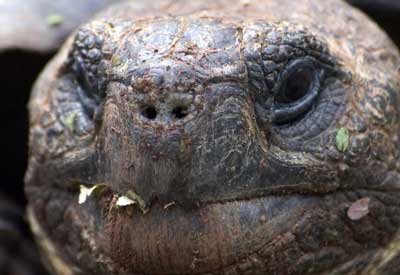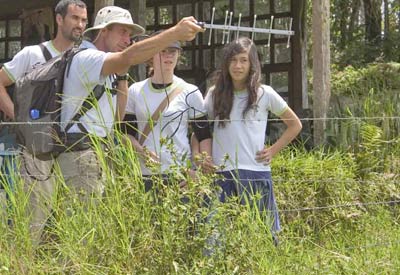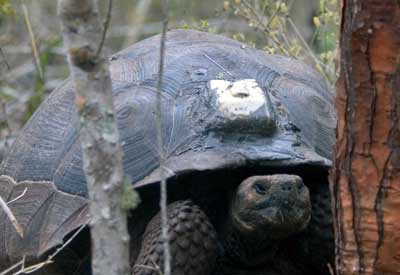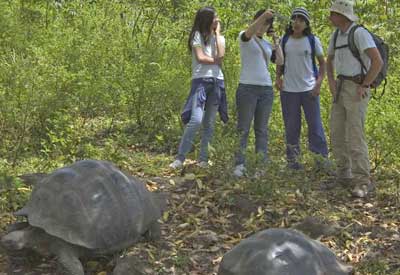Tomas de Berlanga School on the Galapagos Islands, Ecuador are working with Steve Blake and team from the Max Planck Institute, the Galapagos National Park, the Charles Darwin Foundation and the Charles Darwin Trust.
Eight tortoises have been fitted with tracking devices, and the pupils have been learning how to locate them in the field.
The data is being input into a website which builds up a picture of the tortoises' lives.
Pupils also interviewed Darwin's great- great- grandson Randal Keynes.
Tomas de Berlanga pupils are also setting up Facebook pages for each tortoise and the children are inventing characters Sebastian, Lolo, and the others...

Here are extracts from "The adventures of finding Lolo" by Tomas de Berlanga's Eighth Grade English class...
Francesca's story
My class and I went on a great adventure to find Lolo, one of the 8 giant Galapagos tortoises that a GPS on its back.
My classmates and I all had different jobs to do. Noa and Carlos were the cameramen, Aisha was the tracker and my job was to help Aisha and eat blackberries.
As the tracker, Aisha had to find Lolo with an antenna and a radio. Once we found Lolo’s signal, we went to find him.

We walked and we walked in the direction that the beeping was coming from and the beeping got louder and louder. We walked a lot and we saw a ton of tortoises.
We arrived in a thick part of the woods and we didn't know where to go. Aisha started to track Lolo with the antenna. I ate a lot of blackberries along the path.
Noa's story
After 40 minutes of walking Aisha tested her machine and the beep was so loud that it surprised her.
We guessed Lolo was near and he was, and when he saw us he turned around and tried to get away. He got tired of people messing with him. Scientists putting the GPS on him and a camera, and then taking the camera out really made him sick.

Lolo was a huge tortoise because he's very healthy. Tortoises in the wild get to eat different things every day. We took a few pictures of Lolo and had a few snacks as well.
Aisha's story
I was the tracker and Francesca my assistant. I was nervous. I had to use a little box and point an antenna towards the woods to hear the beeps coming from Lolo’s GPS.
I tried my best to hear something. It was really low, but I could tell which direction we needed to go.
It's really beautiful in the woods and there are turtles everywhere. It was amazing! After 5 minutes we realized we were late. It wasn't long after we found him.

Lolo was in an open area we believed was made by the tortoises themselves.
It could have taken them hundreds of years to make this clearing, maybe more! Just imagine tortoises pushing trees, leaves, sticks, grass, and logs around for that long. It is a beautiful thought!
Soham's story
Then I had to go near Lolo and l had to download the information from the GPS of all of his movements.
It was very easy because I only had to press a button to turn it on and the same button to turn it off.
We stayed with Lolo for only 10 minutes; we had to go back quickly because we were late for the bus. We went back almost running.
My friend Noa fell with the camera and everyone laughed.
We keep walking. My teacher thought we had to go one way but I said that it was another way. I was right. Last we had to climb the huge hill. I was really tired!!!
Finally we got on the bus to go home.
 Read more from schools inspired by Darwin
Read more from schools inspired by Darwin
How did they do that?
You can find out more about Tomas De Berlanga's work at The Galapagos Tortoise Project.
The school's project is supported by:
Steve Blake of the Charles Darwin Foundation for Galapagos and the Max Planck Institute
National Geographic Society research with 'crittercams' filming from tortoises backs
The Galapagos National Park
The Charles Darwin Foundation
Randal Keynes and the Charles Darwin Trust
Pupils are developing their ICT and English language skills, as well as finding out about the tortoises.
Join BBC World Class and our partners will help you twin.
The BBC is not responsible for the content of external websites.